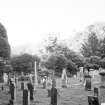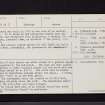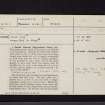Ancrum, Old Ancrum Church
Church (Medieval), Church (18th Century)
Site Name Ancrum, Old Ancrum Church
Classification Church (Medieval), Church (18th Century)
Alternative Name(s) Livingston Church
Canmore ID 57097
Site Number NT62SW 2
NGR NT 62150 24885
Datum OSGB36 - NGR
Permalink http://canmore.org.uk/site/57097
- Council Scottish Borders, The
- Parish Ancrum
- Former Region Borders
- Former District Roxburgh
- Former County Roxburghshire
Ancrum 3, Roxburghshire, cross-slab
Measurements: H 0.83m, W 0.28m
Stone type: cream-coloured old red sandstone
Place of discovery: NT 6215 2485
Present location: built into the exterior of the north wall of Old Ancrum church, above the lintel of the lower of two blocked windows near the west end of the church. The church was built in 1762.
Evidence for discovery: found in 2016.
Present condition: trimmed for re-use but the incised lines are clear.
Description
The dressed face of this slab is incised with a double outline cross, using a fine line.
Date: ninth or tenth century
References:
Desk-based information compiled by A Ritchie 2017
Ancrum 4, Roxburghshire, carved fragment
Measurements: H 0.24m, W 0.14m
Stone type: deep red old red sandstone
Place of discovery: NT 6215 2485
Present location: re-used as part of the internal left-hand jamb of the north window in the east wall of a burial enclosure built in 1872 at the east end of Old Ancrum church.
Evidence for discovery: found in 2016.
Present condition: trimmed for re-use and very weathered.
Description
One of the two visible faces of this stone bears traces of relief-carving, possibly dense interlace similar to that on Ancrum 1. This face forms part of the internal window surround and the other face has been trimmed.
Date: ninth or tenth century
References:
Desk-based information compiled by A Ritchie 2017
NT62SW 2 62150 24885
NT62SW 2.01 NT 6215 2485 Hogback Stone; Graveyard
(NT 6215 2488) Church (NAT).
OS 25" map, Roxburghshire, 1st ed., (1859).
Church (NR) (In Ruins)
OS 6" map, Roxburghshire, (1923).
Parish Church, Hog-backed Stone, etc.
The former parish church of Ancrum is now reduced to its foundation. Beneath the turf of the church-yard, about 20yds S of the ruin, there lies a hog- backed stone about 6ft 4in in length, ornamented on both sides with five rows of shingle ornament. It was recorded in 1922, when more of the stone appears to have been above the surface, that its breadth was 1ft 10in at the head and 1ft 2in at the foot, and its height 1ft at either end and 1ft 1 1/2in in the middle. (J H Craw 1922). The churchyard also contains two small headstones of earlier date than 1707. The first, which has a shaped top, is carved on one side with a winged hour-glass, a skull, and a cherub's head. Behind the skull runs a scroll, bearing a motto in two lines, only the first words of each, respectively LIVE and MINDE, being legible today. On the back runs the inscription HERE LYES/IAMES LIGERTUOD/TENNANT IN H(OU)/ NDLIE UHO DIED/SUPTR 14 1621/HIS AGE 74/AS ALSO ISOBELL/LIGERTWOOD DAUT(E)R/TO WALTER LIGERT/UOOD TENNANT IN/MENHOUSE WHO DIED/ OCTBR 16 1720 HIR AGE 25. The second stone, also with a shaped top, displays in front a crudely carved skull and cross-bones, while the back bears the inscription HERE LYES/ADAM RICHARDSON/ WHO LIVED IN ANE ONEST REPUT ALL/HIS DAYES AND DIED/ IN OCTOBER THE 19/1701 AND OF HIS/AGE 55.
Bell.
The bell of the modern parish church, now inaccessible, is understood to bear the inscription MICHAEL BVRGERHBVYS ME FECIT 1618.
RCAHMS 1956, visited 22 March and 13 October 1933.
This church was built in 1762 on the site of an earlier church. It is known as the Livingston Church from the fact that the celebrated John Livingston, a leading 17th century churchman, preached here, as minister of the parish, from 1648-62.
The present parish church (NT 6267 2456) was built in 1890 when, presumably, its predecessor was abandoned.
(P W Lilley 1934; New Statistical Account (NSA, Rev J Paton 1837) 1845; F H Groome 1901).
The walls of this church are still extant to a greater degree than suggested by the RCAHMS. The east and west gables stand almost to their original height and the north wall has an average height of c 3.0m.
The south wall is broken in places to facilitate burials within the walls. A stone, inscribed '1762' is in the west gable.
The hog-backed stone was located at NT 6215 2485, protruding slightly above the turf. The headstones described by the RCAHMS are still evident.
No traces were seen of an earlier church nor could the name 'Livingston Church' be confirmed.
Hog-backed stone surveyed at 1/2500.
Visited by OS (WDJ) 23 January 1967.
Field Visit (22 March 1933 - 13 October 1933)
Parish Church, Hog-backed Stone, etc.
The former parish church of Ancrum is now reduced to its foundations. Beneath the turf of the church-yard, about 20yds S of the ruin, there lies a hog- backed stone about 6ft 4in in length, ornamented on both sides with five rows of shingle ornament. It was recorded in 1922, when more of the stone appears to have been above the surface, that its breadth was 1ft 10in at the head and 1ft 2in at the foot, and its height 1ft at either end and 1ft 1 1/2in in the middle (Craw 1922, 188).
The churchyard contains only one stone of earlier date than 1707. This, a small headstone, has a shaped top, has a shaped top and displays in front a crudely carved skull and cross-bones, while the back bears the inscription HERE LYES / ADAM RICHARDSON / WHO LIVED IN ANE ONEST REPUT ALL / HIS DAYES AND DIED / IN OCTOBER THE 19 / 1701 AND OF HIS / AGE 55.
Bell.
The bell of the modern parish church [NT62SW 195], now inaccessible, is understood to bear the inscription MICHAEL BVRGERHBVYS ME FECIT 1618.
RCAHMS 1956, visited 22 March and 13 October 1933.
Sbc Note
Visibility: Upstanding building, which may not be intact.
Information from Scottish Borders Council
Sbc Note
A probable cross base was observed during a site visit in August 2016 by the SBC Archaeology Officer and members of the Ancrum & District Heritage Society resting against the north-west corner of the church (approximately at NT 62145 24891). This natural boulder has been roughly flattened at the top with a rectangular socket carved into the stone. The stone is approximately 1 metre high by .5 metres wide.
































